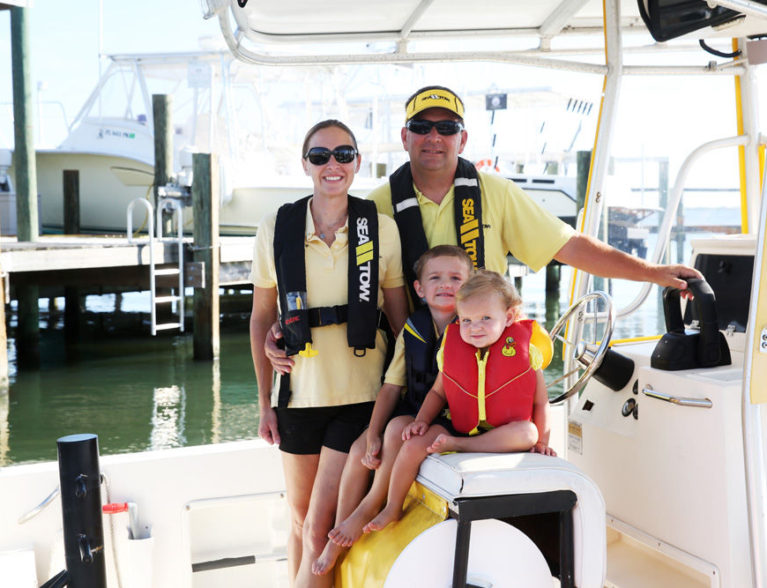
SEBASTIAN — United States Coast Guard-licensed Captains John and Amy Donaldson have about as much experience and expertise as a stranded/broken-down/out-of-gas boater could wish for.
The energetic couple have operated the Sebastian-based Sea Tow franchise for just a little over a year now and have already become a familiar sight on local waters in one of their unmistakable black and yellow boats, or participating in various community events, such as the annual Waterway Clean-Up last month or the recent Sebastian Chamber Grill-Out Night.
Sitting in their Sebastian living room, it is clear they “walk the talk” when they say they’re available 24/7/365.
Navigational charts, files and communications equipment share the space with a colorful collection of toys, the property of 4-year-old Finnegan and little sister Fiona, playing nearby and jumping on and off dad’s lap. As the radio blurts out now and again, the Donaldsons talk about their business and how a young family from Cape May, NJ, came to settle in Sebastian.
John explained that Sea Tow International began in 1983, when the U.S. Coast Guard realized it had to come up with a way to handle the ever-increasing number of non-emergency break-downs and towing requests it was called to handle, which had begun to compromise its ability to respond to real emergencies. The Coast Guard, John said, went to the Fed and basically said they needed a lot more funding to increase capability or the non-emergency part of the service should be privatized.
The Fed, no big surprise, opted for Plan B, and Commercial Assistance Tow came into being. From then on, the Coast Guard handled life-threatening situation and other true emergencies, and “Sea Tow” would handle the others. Coastal waterways are divided into franchised coverage areas and, says John, there are very, very few “gaps.”
As it developed, Sea Tow became a membership based operation: They’ll respond to any call, member or not, but a typical tow runs about $250-$300/hour, with a 1-hour minimum. An annual membership gets a boater free towing, jump starts, fuel drops and covered ungroundings.
For a recreational boater, says Amy, an annual membership is $169 and, “it covers any and all watercraft registered in your name.” The service is also available for commercial and professional boaters, at different annual rates.
There are, John adds, no limit to the number of calls a member makes, “as long as it’s in good faith.”
The Donaldsons’ business is officially named Sentinel Marine Services Inc. DBA Sea Tow. Their membership coverage area stretches from Eau Gallie south to the 17th Street Bridge, and they’ll provide a tow from virtually wherever a member’s boat is located.
As far as how far out into the ocean Sea Tow will go, that mostly depends on the size of member’s communications capability. SeaTow, and most recreational boats, use line-of-sight communication equipment: if a member is stranded beyond that, unless he has a high tech radio, communication isn’t going to happen. Whether a stranded boater contacts the Coast Guard or Sea Tow, he will get a response.
John Donaldson, a captain and a professional salvage diver, has spent many years in the business, mostly with North Star Marine of Cape May. From 20-foot recreational boats to the giant commercial freighters and tankers that ply Delaware Bay, transporting crude from the huge refineries in Pennsylvania, New Jersey and Delaware, he has worked with them all. Much of his time was spent in oil recovery.
“We did a lot of stand-by, manning an OSRV (Oil Spill Recovery Vessel).”
He explains that Delaware Bay is the site of the world’s largest lightering operation, which is the transferring of crude oil or petroleum products between two vessels.
“The Beverly Hillbillies gave people the wrong impression of what crude oil looks like. It’s not that nice and smooth.”
Amy was working as a graphic designer for a newspaper in Cape May, but she wasn’t happy. “I’m NOT an indoor person! I wanted to work on boats.”
Everybody knew everybody in the small town of Cape May, so John was acquainted with Amy’s family. So she was able to get a job working for another enterprise of his, parasailing. Eventually she became a Certified Dive Control Master and, in 2005, also became a certified Captain.
After years working together, John had decided to propose to Amy. With their friends all in on the plan, he plotted to surprise her by popping the question during a dive. Although they usually wore gloves, he knew the ring wouldn’t fit, so he tricked her into leaving them in the boat. Then, in the sparkling waters of the Florida Keys, 30 feet below the surface, surrounded by their friends, John retrieved the beautiful aquamarine ring he had placed inside a small Indonesian clam shell, and hidden in a sand bank. He got down on one knee and a friend aimed a camera. Amy , after recovering from her shock that John and their pals had all been in on it, accepted the unique proposal, and the moment was captured on film. They married in Nassau 2007.
John knew that the 24-7 on-call life of big time salvage and oil spill response was great for a single man, but would be “a tough life for a guy with a family.”
So he had finally left North Star, and concentrated on several other more family-friendly endeavors.
Then, Amy recalls, “One day I said to him, ‘I do not like winter. I like Jimmy Buffett. Let’s go to Florida.’ He said ‘OK.’”
They spent 8 ½ years in Naples and were working for the owner of the Sea Tow franchise there, but weren’t fond of the Gulf Coast. Seeking a place to relocate, they discovered Sebastian, and the Treasure Coast.
“We like Sebastian a lot. It reminds us of our home town – Cape May,” says Amy.
John says he heard someone describe it perfectly: “Mayberry Meets Margaritaville.”
For more information: 321-254-1242.



